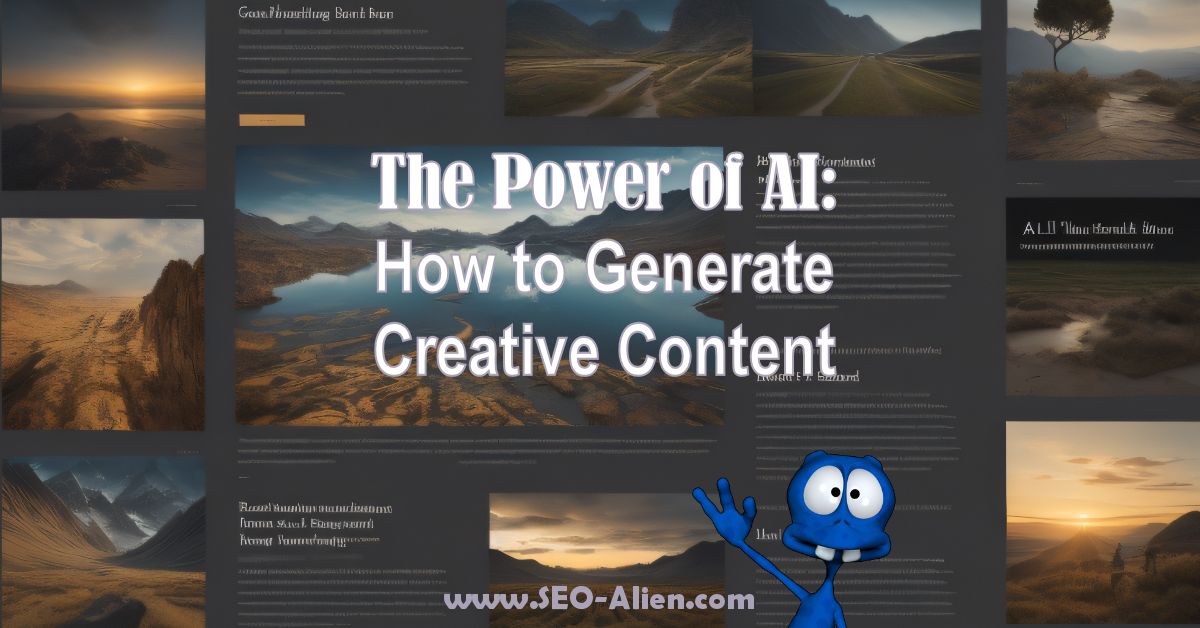Welcome to the world of artificial intelligence (AI) and the power of prompts!
In this article, we'll explore how prompts serve as crucial instructions that enable you to harness the full potential of AI.
Get ready to unlock the possibilities and make the most of AI's capabilities with the magic of prompts!

In a way, crafting the perfect prompt for AI tools like ChatGPT is akin to concocting a delicious recipe. Just as carefully chosen ingredients and precise instructions elevate a dish from bland to brilliant, so too does a skillfully worded prompt guide the AI towards an exceptional outcome. Each element – keywords, tone, context – acts as a culinary spice, infusing the final text with flavor, depth, and purpose. Just like a gourmet chef, a skilled prompter knows how to nudge the AI in the right direction, coaxing out its full potential to create content that delights, informs, and resonates. So, next time you sit down to craft a prompt, remember – you're not just giving instructions, you're weaving a recipe for words that will tantalize your audience and leave them hungry for more.
This final paragraph adds a playful and relatable twist to the article, tying back to the earlier mentions of building brand authority and gaining customer insights. It also hints at the potential of AI writing tools, further engaging the reader in the topic.
In the world of artificial intelligence (AI), prompts are essential for getting the results you want. A prompt is a set of instructions that tells AI what you are looking for. By using the right prompts, you can guide AI to generate text, images, code, and other creative content that is exactly what you need.
We will cover the following topics:
1. What are prompts?
A prompt is a set of instructions that tells AI what you are looking for. It can be a single word, a phrase, or a sentence. The goal of a prompt is to provide AI with enough information to generate the desired output.
For example, if you want AI to generate a poem about love, you might use the prompt "a love poem". This prompt tells AI that you are looking for a poem about love. It also tells AI that you want the poem to be in a specific genre.
2. How to write effective prompts
There are a few things to keep in mind when writing effective prompts for AI:
- Be specific. The more specific you are, the better the results you will get. For example, instead of saying "a poem about love", you could say "a sonnet about a lost love".
- Use keywords. Keywords are words that are associated with the topic you are interested in. For example, if you are looking for AI to generate an image of a cat, you might use the keywords "cat", "feline", and "whiskers".
- Use examples. If you can, provide AI with examples of the type of output you are looking for. This will help AI to understand what you want.
3. Examples of AI prompts for different tasks
AI prompts serve as powerful tools to unlock the potential of artificial intelligence across various tasks, from crafting engaging blog posts to designing captivating images and compelling call-to-action (CTA) messages.
Below are a collection of diverse examples of prompts for various tasks to spark your inspiration and pave the way for you to create your own innovative and impactful AI-driven content. Here are some examples of prompts for different tasks:
AI Prompts to create a blog post with desired tone and style
- "Craft a blog post with an upbeat and friendly tone, suitable for a casual audience interested in [topic]."
- "Create a blog post that conveys a professional and informative tone, catering to [target industry/audience] seeking insights on [subject]."
- "Develop a blog post with a persuasive and authoritative style, targeting [potential customers] looking to [address a specific pain point]."
- "Write a blog post with a humorous and engaging tone, geared towards [target demographic] interested in [topic] for entertainment and education."
- "Compose a blog post with an empathetic and compassionate tone, aimed at providing support and guidance to readers facing [challenges]."
- "Produce a blog post with a thought-provoking and contemplative style, inviting readers to reflect on the impact of [topic] in their lives."
- "Generate a blog post with a succinct and to-the-point tone, appealing to busy professionals seeking quick tips and solutions for [problem]."
AI Prompts to generate a compelling value-driven blog post:
"Unlocking the Power of [product/service name]: The Ultimate Solution for [target customers] Looking to [customer need or problem]. [product/service name], a Cutting-Edge [product category], Delivers [key benefit/primary differentiator] Unlike Any Other. Say Goodbye to [competitors] – Discover How [product/service name] Empowers You to [key benefit/outcome]."
AI Prompts to generate Metadata from an article:
"Write a meta description that is less than 160 characters including spaces, write an excerpt, find the 3 best SEO keyphrases within this article, write 3 hashtags, write 2 facebook posts for this article:"
2. How to write effective prompts
There are a few things to keep in mind when writing effective prompts for AI:
- Be specific. The more specific you are, the better the results you will get. For example, instead of saying "a poem about love", you could say "a sonnet about a lost love".
- Use keywords. Keywords are words that are associated with the topic you are interested in. For example, if you are looking for AI to generate an image of a cat, you might use the keywords "cat", "feline", and "whiskers".
- Use examples. If you can, provide AI with examples of the type of output you are looking for. This will help AI to understand what you want.
3. Examples of AI prompts for different tasks
AI prompts serve as powerful tools to unlock the potential of artificial intelligence across various tasks, from crafting engaging blog posts to designing captivating images and compelling call-to-action (CTA) messages.
Below are a collection of diverse examples of prompts for various tasks to spark your inspiration and pave the way for you to create your own innovative and impactful AI-driven content. Here are some examples of prompts for different tasks:
AI Prompts to create a blog post with desired tone and style
- "Craft a blog post with an upbeat and friendly tone, suitable for a casual audience interested in [topic]."
- "Create a blog post that conveys a professional and informative tone, catering to [target industry/audience] seeking insights on [subject]."
- "Develop a blog post with a persuasive and authoritative style, targeting [potential customers] looking to [address a specific pain point]."
- "Write a blog post with a humorous and engaging tone, geared towards [target demographic] interested in [topic] for entertainment and education."
- "Compose a blog post with an empathetic and compassionate tone, aimed at providing support and guidance to readers facing [challenges]."
- "Produce a blog post with a thought-provoking and contemplative style, inviting readers to reflect on the impact of [topic] in their lives."
- "Generate a blog post with a succinct and to-the-point tone, appealing to busy professionals seeking quick tips and solutions for [problem]."
AI Prompts to generate a compelling value-driven blog post:
"Unlocking the Power of [product/service name]: The Ultimate Solution for [target customers] Looking to [customer need or problem]. [product/service name], a Cutting-Edge [product category], Delivers [key benefit/primary differentiator] Unlike Any Other. Say Goodbye to [competitors] – Discover How [product/service name] Empowers You to [key benefit/outcome]."
AI Prompts to generate Metadata from an article:
"Write a meta description that is less than 160 characters including spaces, write an excerpt, find the 3 best SEO keyphrases within this article, write 3 hashtags, write 2 facebook posts for this article:"
5. AI Prompts to generate images:
- "A photorealistic image of a cat",
- "A 3D rendering of a cityscape"
- "An abstract painting in the style of Picasso"
- "an award winning photograph of a sunset, 3d render, sharp, HDR, 64k, tropical"
- Generate an image with a vibrant and energetic tone, depicting [subject] in a dynamic and lively manner."
- "Create an image with a serene and calming style, portraying [theme] in a peaceful and soothing setting."
4. AI Prompts to create different styles of call-to-action (CTA) messages
When instructing AI to create different styles of call-to-action (CTA) messages, you can use the following prompts:
- "Generate a bold and attention-grabbing CTA that encourages readers to 'Act Now!' for a limited-time offer on [product/service]."
- "Create a subtle and persuasive CTA inviting users to 'Discover More' about our exclusive [benefit/feature]."
- "Produce an urgent and compelling CTA urging customers to 'Don't Miss Out!' on our biggest sale of the year."
- "Design a friendly and welcoming CTA encouraging visitors to 'Join the Community' and stay updated on the latest news and events."
- "Generate a confident and action-oriented CTA prompting users to 'Get Started' on their journey towards [goal/outcome]."
- "Create an engaging and interactive CTA inviting readers to 'Try It Now' and experience the magic of [product/service]."
- "Produce a personalized and customer-centric CTA using 'Claim Your [discount/reward]' to show appreciation for loyal customers."
- "Design a curiosity-driven CTA encouraging visitors to 'Unlock the Secret' behind our innovative [solution/technology]."
- "Generate a straightforward and clear CTA guiding users to 'Subscribe Today' for exclusive updates and content."
- "Create a sense of urgency with a time-sensitive CTA like 'Last Chance to Save!' on [product/service]."
Remember that the effectiveness of the prompt will depend on the AI model's capabilities and the specific language it is trained on. Experimenting with different prompts and customizing them to suit your specific goals and target audience can yield more impactful and relevant outputs.
4. Tips for using prompts
Here are some tips for using prompts for AI:
‣ Experiment. Don't be afraid to experiment with different prompts. See what works best for you.
‣ Be patient. It may take some time for AI to generate the desired output.
‣ Be creative. Use your imagination to come up with new and interesting prompts.
Call to action
Unleashing AI's Potential: Mastering the Art of Prompts!
Prompts are an essential tool for getting the most out of AI. By using the right prompts, you can guide AI to generate text, images, code, and other creative content that is exactly what you need. I hope this blog post has given you a better understanding of how to use prompts for AI. If you have any questions, please feel free to leave a comment below. Thank you for reading!
Do you have a favorite prompt you use for writing content or creating and image when using AI? I would love to hear what it is. Please let me know by leaving a comment below.
About the Author:
The SEO-Alien is a project started in 2009 regarding all things online marketing. The site started out more of a diary of predictions, suggestions and references to things I frequently used for online marketing... before social media marketing was even an option.
I hope you find the information and tools presented here useful and something worth sharing with others.
If there is anything else about online marketing or any online advertising strategy you think would be helpful, please let me know.




